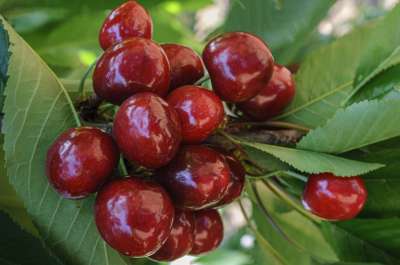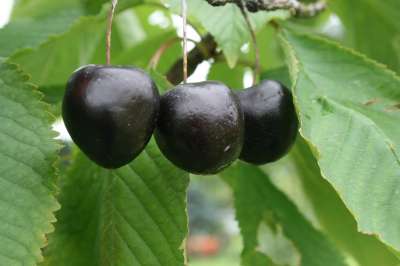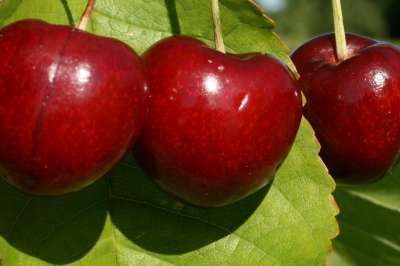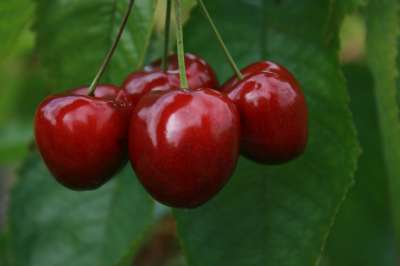Your basket is currently empty!
The temptation of growing bunches of stunning-looking sweet and juicy cherries is definitely within the scope of all and cherry trees are generally easy to grow. One or two points to remember though:
You can view our extensive online range of cherry trees here.
Sweet cherries generally are less suited to Northern localities.
Wherever you grow them be prepared to give them protection from birds or our beaky friends will get there first! This is remedied most easily by growing smaller trees in containers, that can be readily netted, or grow them in a fruit cage or against a wall where you can again net them more easily..
Morello cooking Cherries are much hardier and can be grown well in the North, in less suitable gardens, and are one of the few fruits that enjoy life on a North facing wall! Pictured below:
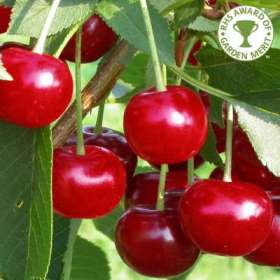
Cherry trees are probably the most attractive of all our orchard trees, not only in blossom when there bows become thickly clustered with snowy white blossom, but also the burning gold and orange of the autumn leaf tints. They are also great for bees and wildlife.
Rootstocks for Cherries
There are really only two that are suited to general garden cultivation.
Colt Rootstock
Colt Rootstock remains the most prevalent and is fairly flexible. It may be grown as a semi-vigorous tree for orchard, lawn, or paddock use yet is quite easily contained by pruning so well suited to smaller area’s too. It is the only rootstock recommended for fan training. You can also festoon Colt rootstock, by pulling young branches down to the main stem and tieing them. This creates a lovely weeping tree with naturally suppressed vigour and is quite easy to do. Colt crops heavily and is suited to most soils. Height – anywhere from 220-400cm’s according to your wishes, spread much the same.
Gisela 5
The first genuinely dwarf rootstock for Cherries has understandably received a lot of attention. It is the only Cherry rootstock really suited to container growing and is easier to place inside a fruit cage. It crops early in life and has shown good compatibility with most varieties. Morello in particular produces stunning results on this rootstock. Gisela 5 can be maintained at just 160-180cm’s in height, or if allowed to grow will make a little more. Highly recommended but requires good soil that does not dry out too readily for the best results. Excels in containers but make sure watering is regular. Gisela 5 requires little pruning or upkeep. Suitable for small bush tree or column work, but not really suited to fan training. This stock has superceded the previous dwarf ‘Tabel’ which has proved difficult to grow well. Gisela 5 will give much improved results.
Prunus avium and F121
These are both much more vigorous and have the capability of making substantial trees. They are not suited to garden growing but can be employed in a larger traditional orchard setting, or a paddock where a large hardy tree is required. It will be very difficult to protect the fruit from birds but they make handsome trees, especially when in blossom.
Good varieties
The self fertile varieties, aside from being convenient choices for the one cherry tree garden, also tend to be the most reliable performers. The following are all sweet black or dark red fruiting cherries that are the easiest to grow:
Sunburst Cherry Tree, Stella Cherry Tree, Summer Sun Cherry Tree, Lapins Cherry Tree [also known as ‘Cherokee’] and Sylvia Cherry Tree. Pictured below is ‘Stella’:

Special mention should go to ‘Penny Cherry Tree’ which has particularly large and impressive fruits [but which requires a pollinator] and also Petite Noir which is naturally very compact and almost dwarfing in habit, even on Colt stock. It is self fertile, sweet and dark red/black. Because grafting wood is produced only sparing, Petite Noir is often in short supply.
If you are looking for a ‘white’ Cherry [which are tremendously sweet with a white inner flesh although the outside is usually flushed pink] then our recommendation would be for Merton Glory Tree. This variety requires a pollinating partner and there are no self fertile white cherry varieties.
Bugs, diseases and maladies of Cherry trees
Bacterial Canker
Bacterial Canker shows it’s presence when gum leaks from the bark. The disease is more troublesome in the wetter area’s of the country and is spread by rain and wind. The best course of action is to cut out infected wood, beyond the point of infection leaving only clean growth. If the canker is on the main trunk or a major limb then spraying with bordeaux mixture can help. Some varieties are more susceptable to canker than others. Cherry trees may also leak a sticky gum when stressed or in general poor health, so it may not automatically be canker.
Blackfly
Blackfly will almost certainly infest the new growths in late Spring and Summer and can quickly sap the trees’ vigour if left uncontrolled. Light infestations can be rubbed off by hand or sprayed with soapy water but more enthusiastic infestations will need treating with an insecticide such as Provado.
Fruit drop
If you find your longed-for burgeoning cherry fruitlets dropping like cowboys in a Western then the cause can be quite complex. Much scientific work has been done on the subject and whilst infrequent watering is undoubtedly the most common cause [too little, too much or too infrequent] light levels and the general health of the tree also play a part. Where light levels are concerned, try to prune the tree so that the canopy isn’t too congested and the maximum amount of sunlight can reach all the main branches. You could try siting next to a white wall or similar reflecting surface. And try to keep the tree happy and growing lushly. To safeguard against fruit drop, you can also self thin the fruitlets yourself shortly after fruit-set, which will encourage the tree to keep what remains to maturity and ensures ample fruit size.
Split fruit
A relatively common occurrence, especially during wet summers. The fruit can still be used but is less satisfactory than perfect fruits. The cause is water – either too little followed by too much rainfall. Heavy downpours can also make the fruit split. Ensuring a constant water supply is the best way to avoid fruit-split, and protecting the ripening fruits from heavy summer downpours. Some varieties have resistance to fruit split.
The weather

Cherries are arguably more affected by bad weather than any of the other fruit trees. Hail, heavy rain, late frosts and wind all conspire to rob you of your deserved fruits. There isn’t much we can do about such things other than provide a sheltered, amicable spot for them to give the best chance of success. The trees are actually pretty cold hardy whilst dormant so winter frosts are seldom a problem. Commercial English cherry crops are actually almost always grown under cover these days to protect them from the vagaries of our spring and summer weather patterns. And it’s the main reason why they are so eye-wateringly expensive to buy in the shops.



